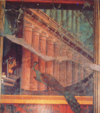 Detail of the living-room E2
Detail of the living-room E2The mural decorations of the large room E2 which is situated on the west side of the villa offer, apart from the architectonic details in perspective and suggestions of chiaroscuro, several particularly effective ornamental motifs: a theatrical mask for example, and a peacock, both of which reappears in paintings in other rooms of the villa.
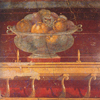 Fresco representing pomegranates
Fresco representing pomegranatesIn the room H2 (see the map) there is a splendid glass bowl-tray containing colourful pomegranates. It decorates the cornice of the murals of the room at the east of the atrium. Notable too are the fine chiaroscuro effects on the cornice. Anyway, the style of this fresco is very similar to another painting with the same subject in the villa of Boscoreale.
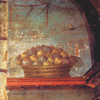 Wicker basket with figs
Wicker basket with figsThe triclinium (E1) is skilfully decorated; the floor with quite simple geometrical designs but the walls with studied architectonic effects - gilded columns set with gems, and ornamental detail such as a bow and quiver of arrows, many-coloured birds, sphinxes, trailing vines. Still life images are notable too however and the detail which stands out most of all on the back wall is a splendid life-like basket of figs.
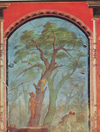 Fresco with Hercules in the Hesperides' gardens
Fresco with Hercules in the Hesperides' gardensOn the wall of the niche at the back of the calidarium (room for the sauna), beneath the high tripartite cornice decorated with stylised details and panels with landscapes, can be seen a large painting of a mythological subject, similar to two others on different walls. We see a new emphasis on the natural setting of the story at the expense of its subject, Hercules advancing through the Garden of the Hesperides, the "daughters of Evening", to steal the golden apples which grew there and carry out the orders of Eurystheus to kill the hundred-headed dragon which stood guard over them.
 External view of the beautiful Roman villa
External view of the beautiful Roman villaThis beautiful Roman dwelling, so-called "Villa of Poppea", represents for sure one of the most imposing and best preserved examples from the antiquity. Still nowadays in this villa it is possible to admire spectacular frescos of great beauty.
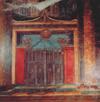 Marvellous fresco of the living-room E1
Marvellous fresco of the living-room E1The wall-paintings in the triclinium E1 (the living-room) are very elegant. On one side several pillars, with fine, stylised trailing vines, frame a doorway with an ornate architrave. This opens out onto an open space in the centre of which a tall circular shrine serves as the base for an image of what is probably a patron divinity. Refined decorative taste is evident in the choise of the ornamental motifs.
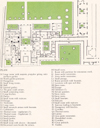 Plan of the so-called "Villa of Poppea"
Plan of the so-called "Villa of Poppea" The architectural complex of the "Villa of Poppea" extended for over 60 metres West-East and more than 50 metres North-South, and this was surrounded by extensive dignified and elegant gardens which were bordered by majestic arcades.
One of the main features of the villa at Oplontis is the wide porticoes which go round long sections of the perimeter and lend a solemn air to the villa.Amongst the best preserved are the colonnades on the north side which run alongside the large room and open onto the vast garden.
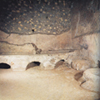 The kitchen of the Oplontis' Villa
The kitchen of the Oplontis' Villa Near the internal garden (B3) on the western side of the villa, the kitchens (C3) were situated together with various passageways, store-rooms and spare-rooms (D1 - C2). Still to be seen are the large hearth on the north wall; the masonry structures which probably supported work tables; and the tank for dirty water outflow or for rubbish disposal.
Near the kitchen there were the thermal baths whose the kitchen itself was the heat generator.
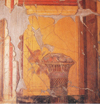 Elegant cane basket covered with a transparent veil
Elegant cane basket covered with a transparent veilOn the eastern side of the great atrium lies the room H2 where there very beautiful frescos.
In particular there is an elegant cane basket, minutely decorated, overflowing with fruit and covered with a transparent veil painted with studied realism.
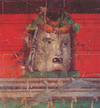 A theatrical mask
A theatrical maskOn the eastern side of the great atrium lies another room (H2) whose use is unknown, but whose walls still bear splendid examples of mural paintings in the II style. On the western wall there is a building drawn in perspective. On the same wall, in the central section, you can find this theatrical mask which is one the commonest pictorial details in the villa.
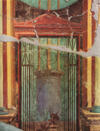 Fresco with the sanctuary at Delfi
Fresco with the sanctuary at DelfiThe east wall of the great room E2 which gives onto the portico G1 (which surrounds the western viridarium - the garden) is finely decorated with paintings in the II style. Between views in perspective and skilful architectonic play with columns is a painting of the sanctuary at Delphi, dedicated to Apollo, and depicting the traditional tripod placed on a column.